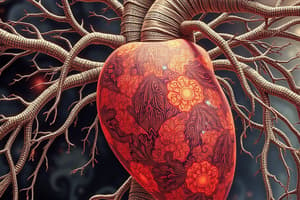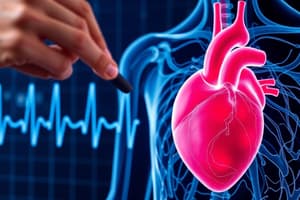Podcast
Questions and Answers
What is the ionic basis of automaticity in cardiac impulse formation?
What is the ionic basis of automaticity in cardiac impulse formation?
- Potassium channel activation
- Chloride channel activation
- Calcium channel activation (correct)
- Sodium-potassium pump activity
What is the mechanism of overdrive suppression in cardiac conduction?
What is the mechanism of overdrive suppression in cardiac conduction?
- Activation of latent pacemakers
- Enhanced automaticity of latent pacemakers
- Inhibition of latent pacemakers by faster pacemakers (correct)
- Electrotonic interactions
What is the characteristic feature of unidirectional block and reentry in altered impulse conduction?
What is the characteristic feature of unidirectional block and reentry in altered impulse conduction?
- Anterograde conduction only (correct)
- Conduction block in both directions
- Retrograde conduction only
- Bidirectional conduction
What is the physiological basis of antiarrhythmic therapy primarily targeting in the cardiac conduction system?
What is the physiological basis of antiarrhythmic therapy primarily targeting in the cardiac conduction system?
Which ion is the main responsible for spontaneous depolarization in pacemaker cells?
Which ion is the main responsible for spontaneous depolarization in pacemaker cells?
What is responsible for the rapid upstroke in nonpacemaker cells?
What is responsible for the rapid upstroke in nonpacemaker cells?
What maintains low intracellular calcium concentration?
What maintains low intracellular calcium concentration?
What determines the resting potential of the cell?
What determines the resting potential of the cell?
Which type of channels are targets of calcium channel blockers?
Which type of channels are targets of calcium channel blockers?
What is responsible for K+ exiting the cell to repolarize it?
What is responsible for K+ exiting the cell to repolarize it?
What maintains ion gradients and resting membrane potential?
What maintains ion gradients and resting membrane potential?
Where does calcium entry occur during phase 2 of the action potential?
Where does calcium entry occur during phase 2 of the action potential?
What membrane proteins are contained in the sarcolemma?
What membrane proteins are contained in the sarcolemma?
What is present on the SR membrane?
What is present on the SR membrane?
What is responsible for gradual depolarization during phase 4 of the action potential in cells with natural automaticity?
What is responsible for gradual depolarization during phase 4 of the action potential in cells with natural automaticity?
What is the role of the Na+/K+ pump in maintaining the cell's ionic balance?
What is the role of the Na+/K+ pump in maintaining the cell's ionic balance?
What is the intrinsic rate of the SA node?
What is the intrinsic rate of the SA node?
Which cells involve a spontaneous phase 4 depolarization and slow inward leak of current until the cell spontaneously depolarizes?
Which cells involve a spontaneous phase 4 depolarization and slow inward leak of current until the cell spontaneously depolarizes?
What maintains resting membrane potential by pumping 3 Na+ out and returning 2 K+ in?
What maintains resting membrane potential by pumping 3 Na+ out and returning 2 K+ in?
Which part of the heart is prone to inflammation and calcified debris that can interfere with impulse conduction?
Which part of the heart is prone to inflammation and calcified debris that can interfere with impulse conduction?
What are arrhythmias that are categorized as supraventricular or ventricular based on their origin called?
What are arrhythmias that are categorized as supraventricular or ventricular based on their origin called?
What results from reduced automaticity or conduction block?
What results from reduced automaticity or conduction block?
What is the intrinsic rate of the AV node?
What is the intrinsic rate of the AV node?
What is the specialized conducting system that includes the SA node, AV nodal region, ventricular conducting system, bundle of His, and Purkinje fibers called?
What is the specialized conducting system that includes the SA node, AV nodal region, ventricular conducting system, bundle of His, and Purkinje fibers called?
What is characterized by rapid depolarization and sustained depolarization before repolarization in nonpacemaker cells?
What is characterized by rapid depolarization and sustained depolarization before repolarization in nonpacemaker cells?
What is involved in phases of rapid depolarization, transient early repolarization, plateau phase, membrane repolarization, and resting membrane potential in nonpacemaker cells?
What is involved in phases of rapid depolarization, transient early repolarization, plateau phase, membrane repolarization, and resting membrane potential in nonpacemaker cells?
What facilitates action potentials in various cardiac regions and cells, capable of bidirectional movement?
What facilitates action potentials in various cardiac regions and cells, capable of bidirectional movement?
What is the term for arrhythmias that vary in severity from benign palpitations to life-threatening conditions?
What is the term for arrhythmias that vary in severity from benign palpitations to life-threatening conditions?
What can lead to overdrive suppression in cardiac impulse formation?
What can lead to overdrive suppression in cardiac impulse formation?
How do electrotonic interactions affect pacemaker cells and myocardial cells?
How do electrotonic interactions affect pacemaker cells and myocardial cells?
What influences the rate of pacemaker cell discharge?
What influences the rate of pacemaker cell discharge?
What can lead to spontaneous conversion of fast response cells to slow pacemaker response?
What can lead to spontaneous conversion of fast response cells to slow pacemaker response?
How many phases are cardiac action potentials divided into?
How many phases are cardiac action potentials divided into?
What does the Q-T interval on the EKG reflect?
What does the Q-T interval on the EKG reflect?
What conditions can cause dysrhythmias?
What conditions can cause dysrhythmias?
What do cardiac arrhythmias relate to?
What do cardiac arrhythmias relate to?
Where may arrhythmias arise from altered impulse formation?
Where may arrhythmias arise from altered impulse formation?
What is the effect of hyperpolarizing current on pacemaker cells?
What is the effect of hyperpolarizing current on pacemaker cells?
What is the main factor influencing the slope of phase 4 depolarization in pacemaker cells?
What is the main factor influencing the slope of phase 4 depolarization in pacemaker cells?
How does severe coronary artery disease affect cardiac pacing?
How does severe coronary artery disease affect cardiac pacing?
What is the main effect of calcium channel blockers on heart rate and conduction speeds in the SA and AV nodes?
What is the main effect of calcium channel blockers on heart rate and conduction speeds in the SA and AV nodes?
What is the role of the absolute refractory period in the cardiac action potential?
What is the role of the absolute refractory period in the cardiac action potential?
What is the characteristic of the relative refractory period in the cardiac action potential?
What is the characteristic of the relative refractory period in the cardiac action potential?
What is the vulnerable zone for dysrhythmias to develop?
What is the vulnerable zone for dysrhythmias to develop?
What is responsible for the action potential upstroke of pacemaker cells?
What is responsible for the action potential upstroke of pacemaker cells?
What determines the firing rate of automatic cells in the specialized conduction pathway?
What determines the firing rate of automatic cells in the specialized conduction pathway?
What sets the heart rate and prevents spontaneous firing of other potential pacemaker sites?
What sets the heart rate and prevents spontaneous firing of other potential pacemaker sites?
Which cells act as backup pacemakers if the SA node slows or fails to fire?
Which cells act as backup pacemakers if the SA node slows or fails to fire?
What changes the firing rate of the cell in the pacemaker current (If)?
What changes the firing rate of the cell in the pacemaker current (If)?
What is the impact of alterations in the pacemaker current (If) on the firing rate of the cell?
What is the impact of alterations in the pacemaker current (If) on the firing rate of the cell?
What determines the intrinsic rates of firing in automatic cells?
What determines the intrinsic rates of firing in automatic cells?
What acts as backup pacemakers if the SA node fails to fire?
What acts as backup pacemakers if the SA node fails to fire?
Flashcards are hidden until you start studying
Study Notes
Cardiac Impulse Formation and Arrhythmias
- Overdrive suppression occurs when the fastest pacemaker cells inhibit other automatic cells from firing, due to ion distribution and hyperpolarizing current.
- Electrotonic interactions occur between pacemaker cells and myocardial cells through gap junctions, affecting their membrane potentials and automaticity.
- The rate of pacemaker cell discharge varies with the resting membrane potential and the slope of phase 4 depolarization, influenced by catecholamines and acetylcholine.
- Changes in cardiac pacing, such as in severe coronary artery disease, can lead to spontaneous conversion of fast response cells to slow pacemaker response, potentially causing serious arrhythmias.
- Cardiac action potentials are divided into 5 phases, with each phase corresponding to specific changes in ion channels and contributing to the EKG waveform.
- The Q-T interval on the EKG is affected by various drugs and can predispose to dysrhythmias.
- Dysrhythmias can be caused by conditions such as myocarditis, viral infections, hypertrophy of myocardial cells, and other inflammatory conditions.
- Cardiac arrhythmias are related to alterations in the specialized cells of the heart's conduction system, affecting automaticity, excitability, conductivity, or refractoriness.
- Arrhythmias may arise from altered impulse formation at the SA node or other sites, including specialized conduction pathways or regions of cardiac muscle.
Cardiac and Vascular Function: Role of Calcium Channel Blockers
- Arterioles and their impact on vascular tone play a crucial role in cardiac and vascular function
- The involvement of contractile cells and pacemaker cells in the excitation-contraction coupling process is vital for heart function
- Calcium channel blockers have a significant impact on heart rate acceleration and increased conduction speeds in the SA and AV nodes
- Refractory periods in the cardiac action potential (AP) and the EKG are essential for ventricular emptying and refilling before the next contraction
- The absolute refractory period does not allow initiation of an AP, while the relative refractory period requires a larger than normal stimulus
- The supernormal excitatory period is a vulnerable zone for dysrhythmias to develop
- Refractory periods are caused by unique two-part gating of fast Na+ channels
- The action potential upstroke of pacemaker cells relies on a smaller calcium current and has a less rapid rate of rise compared to non-pacemaker cells
- Automatic cells in the specialized conduction pathway have different intrinsic rates of firing, determined by the slope of phase 4 spontaneous depolarization, maximum negative diastolic potential, and threshold potential
- The SA node, with the fastest rate of depolarization, sets the heart rate and prevents spontaneous firing of other potential pacemaker sites
- Latent pacemakers, such as the AV node and the bundle of His, act as backup pacemakers if the SA node slows or fails to fire
- Alterations in the pacemaker current (If), magnitude of the maximum diastolic potential (MDP), and threshold potential change the firing rate of the cell
Studying That Suits You
Use AI to generate personalized quizzes and flashcards to suit your learning preferences.




